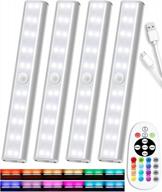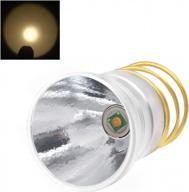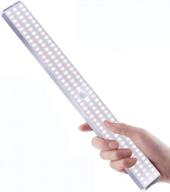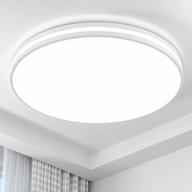
Review on 💡 Streamlight 73001 Nano Light Keychain Flashlight - Miniature LED, Black - 10 Lumens by Joshua Nation

Comparison of Streamlight Nano and UST Pico
The Streamlight Nano has been hanging on a keychain for 8 months and has served me well. I stumbled across the UST Pico a few weeks ago and just had to try it out. Since both lights are targeting the same market, use the same batteries, are roughly the same price, and have many of the same features, I figured the best way to review them would be to compare them against each other. Size and shape are an advantage. :Nano Both Nano and Pico are 0.5 inch in diameter at the head and 1.5 inch from nose to tail. However, they have different shapes. The Pico is a true cylinder, with no real difference in head and body diameter. The Nano's head expands and the body diameter is about 3/8 inch. The Nano's slim body and flared head allows your thumb to rest on it, making it a little easier to direct the beam where you want it. Construction - Advantage: DrawBoth lights are made of anodized aluminum with recessed bulbs. They are well built and seem willing to handle some stress. Both have knurled heads for better grip when turning the lights on and off.*** UPDATE 12/29/2014 ***Version--Advantage: DrawBoths are anodized aluminum in different colors (btw color choice will greatly affect the price of each light) . or a zip-up pico coat, it will probably look new for a while. However, if you attach it to your keys like I did, expect the anodizing to wear off fairly quickly with lots of scratches. This is purely a cosmetic issue and is of no concern to me, but if it is of concern to you please note that none of these lights have an extremely durable finish. ***Battery usage - benefit: unspecified I haven't tested them myself, but Streamlight claims the Nano runs for 8 hours on a single set of batteries, while UST claims 15 hours. It seems to me that UST has perfected their technology to the point where they can almost double the runtime of the Nano. Perhaps Streamlight refers to useful light and UST to the number until it goes out completely. If the nano were brighter and the pico dimmer, those numbers would make more sense, but as you'll read in a moment, that's not the case. I can't tell any difference between them in terms of brightness; Both are very bright for their size. Throwing both lights is also equivalent. The light from Nano is a bit purer white and the light from Pico is a bit more yellow. The pico beam shape is a more uniform circle, while the nano beam shape is slightly more oval. None of them strike me as significantly better. Let's say the uniformity of the pico is balanced by a pure white nanobeam. ***UPDATE 11/23/2014***Some questions and other feedback prompted me to add this: So how bright are the nano and pico lights and what can and should they be used for? They are quite sufficient and sometimes too bright for the following activities in dark surroundings: 1. Walk from the car to the destination and back; From 0 to 20 feet, you can easily identify anything you need to get through or around.2. Walk around the house without turning on the lights and without waking everyone else.3. Looking for something in a closet/wallet/safe.4. Reading (too light for me).5. A signal to other hunters to organize a corral or simply to alert them to your presence. As another point of reference, I can walk into my basement (with white painted walls) alone at night with this light and identify anything, whether it's 1 foot or 40 feet away. Dissatisfaction with the brightness of these lights is due to one of three things: 1. Faulty light - I've never experienced that.2. Low battery is an easy situation to fix.3. unrealistic expectations. You should not expect to use these lights for search and rescue, wildlife viewing, or caving. You will not use them to set paper on fire or blind an attacker. There are plenty of other larger, heavier, more expensive flashlights on the market that can do all of these things - keep an eye out for the Surefire, Fenix, or higher-end offerings from Streamlight, or one of a dozen other like-minded manufacturers. The Pico and Nano are smaller than your pinky and weigh less than half an ounce. Keep these facts in mind and you will be VERY impressed with their light output. *** Operation -- Advantage: Both PICO lights work the same way. Point the flashlight away from you and turn the back of the flashlight clockwise (or counterclockwise) to turn the light on and vice versa to turn it off. However, there is a difference here too. Candles are divided in different ways. Pico's pivot point is 1/8" from the front. Place this narrow head between your fingers and you have a 1.25" spine that can be gripped and rotated. On the other side, the Nano's pivot point is 0.75 inches from the head. Just long enough to get between your thumb and forefinger. However, this leaves your other fingers only half an inch to grab. Because of this, you may find that your back fingers are also grabbing the front, against which Front face is struggling and therefore the turning harder than it should be it doesn't matter and both designs work but for me the pico design is a bit better to make a normal eraser to put the batteries in the nano the best way is, which I found stacking them on the counter, disassembling the nano, then sliding the nano's body over the batteries, tilting it and placing your finger over the hole, then e again screw in. At any stage in the process, these tiny batteries can try to fly apart. On the other hand, the Pico comes with a plastic case where the batteries go. Once they're in, you can shake them and they won't come out. Then you put the whole bracket in the lamp, screw it tight again and you're done. You can control any system, and with a minimum runtime of 8 hours, you don't have to change batteries often, so battery installation isn't a big deal. But the pico system is definitely simpler. Self-Destruct Tendency: PICOM Many reviewers have complained that the Nano has a tendency to twist and fall apart. Following the advice of another reviewer, I put sealing tape on the threads and I've never had a case where the Nano has fallen apart on its own. In truth, both lights can fall apart on their own, and both benefit from the use of tape to seal the threads. The difference is that when the Pico falls apart, it is in three parts and the batteries are together. When Nano falls apart, there will be six with scattered batteries. Fewer hardware = Pico Advantage Snap Hooks - Advantage: DrawBoth features strong snap hooks that make it easy to attach keys and zips. Nano's hook surfaces are slightly flatter, while Pico's are more rounded. If they're not exactly the same size, they're so close together that the difference is negligible. Price - Advantage: PICO This is always subject to change, but as of early October 2014, the Revain Nano costs around $8-9. and Pico for around $6-9, with color choices determining exact price. That's all. Unless I find in the future that the Pico doesn't have the same durability as the Streamlight, my keychain flashlight needs will be covered by Pico from now on. The price difference is reason enough, but performance, the promise of longer battery life, and easy battery installation come first. The Nano is by no means a bad product, and don't fret if you're the recipient of one in the future. But if you buy I would choose Pico.
- White LED 5mm diameter, impact resistant with a lifespan of 100,000 hours
- Non-automatic
New products
Comments (0)
Top products in 🔦 Flashlights

Rechargeable Wireless 48LED Under Cabinet Lights With Remote Control, Dimmable Kitchen Counter Lighting Closet Light RGB 15 Color Changing - 4 Pack (SZOKLED)

42 Review

Super Bright Yellow Light Led Replacement Bulb Single Mode P60 LED Drop-In Module Design For Surefire Hugsby C2 G2 Z2 6P 9P G3 S3 D2 Ultrafire 501B 502B And Other Hunting Flashlights

45 Review

132 LED Closet Light: Motion Sensor Cabinet Lights for Kitchen, Stairs, Wardrobe - USB Rechargeable & Super Bright

52 Review

Modern Round LED Ceiling Light Fixture - Waterproof 24W Flush Mount Daylight Lighting For Bedroom, Kitchen, Bathroom, Living Room, Hallway - Enhanced SEO

46 Review
Another interesting products

💪 Bondic UV Liquid Plastic Welder - Fast Cure, Strong Adhesive Repair Kit for Home, Garage, Outdoors, etc. - Complete Starter Set (LED Light & Liquid Cartridge in Compact Tin Case)

9 Review

Pack Of 1 Natural Wood Color 8 Ounce Bottle Gorilla Wood Glue

42 Review

Hemway Glitter Grout Tile Additive: Sand Gold Sparkle For Your Bathroom, Kitchen And Wet Room Tiles - Easy To Use And Temperature Resistant!

10 Review

Silver Holographic Stars Glitter Grout Tile Additive 100G - Easy To Use For Tiles, Bathroom, Wet Room & Kitchen

14 Review

